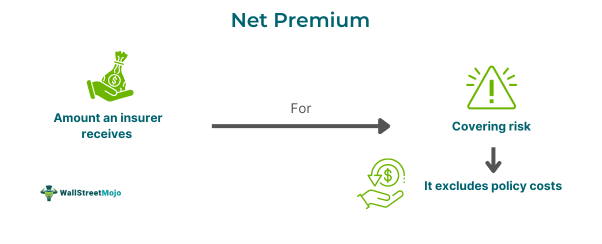Table of Contents
Key Takeaways
- Net premium is the amount of money an insurer will receive for the risk of offering an insurance policy.
- The expected present value of the policy minus the expected present value of future premiums determines it.
- The value of net premiums allows insurance companies to track taxes. The most common premium tax is 2.5%, whereas the maximum is 4%.
- Insurance companies sometimes declare a net premium in their financial reports to help business analysts understand their business's growth.
Formula
To calculate net premium, the present value of anticipated benefits (premiums collected) is subtracted from the expected future value of premiums (expenses such as commissions, claims, and administrative costs).
Net premium = Policy's expected present value - Expected future value of premiums (expenses).
Examples
Below are two examples to help you understand the concept better:
Example #1
Suppose an insurance company XYZ has offered an insurance policy with a net present value of $90000 and incurs a projected future premium/expenses value of $9000.
The net premium can be easily calculated by implying the formula = Present value benefits - Expected present value of future premiums.
90000 - 9000 = $81000.
Every year, an insurance company declares its financial reports and mentions the rise or decline in its net premium for the general public, business analysts, and investors to help them understand the company's financial health and performance.
Example #2
Let’s examine Berkshire Hathaway's recent financial performance to understand the significance of net premiums. Berkshire Hathaway reported a record quarterly profit in the first quarter, mostly due to higher revenue from insurance underwriting. Operating profit for the first quarter of the year increased by 39% to $11.22 billion from $8.07 billion in the previous year.
This increase in profit emphasizes how essential it is to manage net premiums well. Profitability is directly impacted by net premiums or the money received from insuring policies after reinsurance expenses. Berkshire's performance illustrates how this financial metric used in the insurance industry can be effectively managed to produce significant financial rewards.
Importance
Its importance is listed below:
- It helps insurers to track the amount they owe in taxes.
- It protects the company from paying a catastrophic loss amount.
- It mainly works and favors the insurance company based on the premium paid by the policyholders.
- This financial metric used in the insurance industry is often coupled with gross premiums to understand the sales tax on an insurance product.
- It is the amount of money an insurance company charges for the risk of providing policy and coverage.

